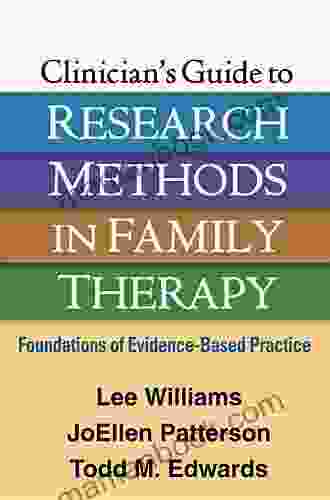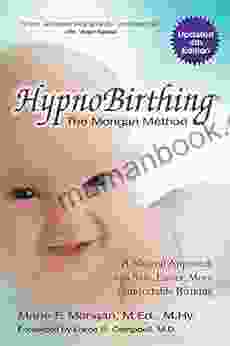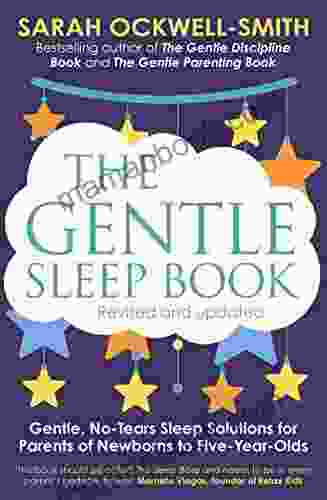Foundations of Evidence-Based Practice: A Comprehensive Guide

Evidence-based practice (EBP) is a systematic approach to decision-making that uses the best available evidence to inform clinical practice. It relies on scientific research and data to provide a foundation for decision-making, as opposed to relying on tradition, personal experience, or intuition. EBP is considered essential in providing safe, effective, and efficient healthcare.
The roots of EBP can be traced back to the 19th century, when physicians began to apply scientific methods to medical practice. In the early 20th century, the development of clinical trials and randomized controlled trials provided a more rigorous way to evaluate the effectiveness of medical interventions. The term "evidence-based medicine" was first coined in the 1990s, and the concept has since been adopted by other healthcare professions.
The principles of EBP are:
4.7 out of 5
| Language | : | English |
| File size | : | 1557 KB |
| Text-to-Speech | : | Enabled |
| Enhanced typesetting | : | Enabled |
| Word Wise | : | Enabled |
| Print length | : | 313 pages |
| Screen Reader | : | Supported |
- Use the best available evidence. This means using the most current, valid, and reliable research studies to inform practice.
- Critically appraise the evidence. This means evaluating the quality of the research studies and determining whether the results are applicable to your patients.
- Consider patient preferences and values. The best available evidence is not always enough to make a decision. You also need to consider patient preferences and values when making a treatment decision.
- Make an informed decision. Once you have considered all of the available evidence, you can make an informed decision about the best course of action for your patient.
The steps of EBP are:
- Ask a clinical question. What is the best way to treat this patient?
- Search for the best available evidence. Do a literature search using databases such as PubMed or Cochrane Library.
- Critically appraise the evidence. Evaluate the quality of the research studies and determine whether the results are applicable to your patient.
- Consider patient preferences and values. Talk to your patient about their goals and preferences for treatment.
- Make an informed decision. Based on the available evidence and patient preferences, make a decision about the best course of action for your patient.
There are many benefits to using EBP, including:
- Improved patient outcomes. EBP has been shown to improve patient outcomes in a variety of healthcare settings.
- Reduced healthcare costs. EBP can help to streamline healthcare delivery and reduce waste.
- Greater patient satisfaction. Patients are more likely to be satisfied with their care when they know that it is based on the best available evidence.
- Increased professional satisfaction. Healthcare professionals who use EBP report greater job satisfaction and a sense of fulfillment.
There are also some challenges to using EBP, including:
- Time constraints. EBP can be time-consuming, especially when you are first starting out.
- Access to resources. Not all healthcare professionals have access to the resources they need to practice EBP.
- Bias. It can be difficult to remain objective when evaluating research studies.
- Changing practice. Putting EBP into practice can require changing your current practice, which can be challenging.
EBP is a systematic approach to decision-making that uses the best available evidence to inform clinical practice. It has been shown to improve patient outcomes, reduce healthcare costs, and increase patient and professional satisfaction. Despite the challenges, EBP is an essential component of quality healthcare.
4.7 out of 5
| Language | : | English |
| File size | : | 1557 KB |
| Text-to-Speech | : | Enabled |
| Enhanced typesetting | : | Enabled |
| Word Wise | : | Enabled |
| Print length | : | 313 pages |
| Screen Reader | : | Supported |
Do you want to contribute by writing guest posts on this blog?
Please contact us and send us a resume of previous articles that you have written.
 Top Book
Top Book Novel
Novel Fiction
Fiction Nonfiction
Nonfiction Literature
Literature Paperback
Paperback Hardcover
Hardcover E-book
E-book Audiobook
Audiobook Bestseller
Bestseller Classic
Classic Mystery
Mystery Thriller
Thriller Romance
Romance Fantasy
Fantasy Science Fiction
Science Fiction Biography
Biography Memoir
Memoir Autobiography
Autobiography Poetry
Poetry Drama
Drama Historical Fiction
Historical Fiction Self-help
Self-help Young Adult
Young Adult Childrens Books
Childrens Books Graphic Novel
Graphic Novel Anthology
Anthology Series
Series Encyclopedia
Encyclopedia Reference
Reference Guidebook
Guidebook Textbook
Textbook Workbook
Workbook Journal
Journal Diary
Diary Manuscript
Manuscript Folio
Folio Pulp Fiction
Pulp Fiction Short Stories
Short Stories Fairy Tales
Fairy Tales Fables
Fables Mythology
Mythology Philosophy
Philosophy Religion
Religion Spirituality
Spirituality Essays
Essays Critique
Critique Commentary
Commentary Glossary
Glossary Bibliography
Bibliography Index
Index Table of Contents
Table of Contents Preface
Preface Introduction
Introduction Foreword
Foreword Afterword
Afterword Appendices
Appendices Annotations
Annotations Footnotes
Footnotes Epilogue
Epilogue Prologue
Prologue Amirah Al Wassif
Amirah Al Wassif Laura Formentini
Laura Formentini Logo Daedalus
Logo Daedalus Sam Brower
Sam Brower Deborah Parker
Deborah Parker Angela Carr
Angela Carr R Barri Flowers
R Barri Flowers Alan Jackson
Alan Jackson Helen Baumann
Helen Baumann Helios Publishing
Helios Publishing Jimmy Moncrief
Jimmy Moncrief Kate Manne
Kate Manne Elizabeth Henshall
Elizabeth Henshall Mary Devey
Mary Devey Aimie K Runyan
Aimie K Runyan Jenna Austin
Jenna Austin L Wilder
L Wilder Peter David
Peter David Luchrisa Valentine
Luchrisa Valentine Guy De Maupassant
Guy De Maupassant
Light bulbAdvertise smarter! Our strategic ad space ensures maximum exposure. Reserve your spot today!
 Dale MitchellFollow ·10.3k
Dale MitchellFollow ·10.3k Heath PowellFollow ·15k
Heath PowellFollow ·15k Kurt VonnegutFollow ·16.9k
Kurt VonnegutFollow ·16.9k Edgar CoxFollow ·17.3k
Edgar CoxFollow ·17.3k Deion SimmonsFollow ·17k
Deion SimmonsFollow ·17k Herbert CoxFollow ·17.5k
Herbert CoxFollow ·17.5k Matthew WardFollow ·6.4k
Matthew WardFollow ·6.4k George R.R. MartinFollow ·6k
George R.R. MartinFollow ·6k

 Ernest Powell
Ernest PowellBenefits of Corporal Punishment: A Review of the...
Corporal punishment is a form of physical...

 Bobby Howard
Bobby HowardThe Development and Significance of African American...
African American...

 Guy Powell
Guy PowellDown Girl: The Logic of Misogyny - A Comprehensive...
In her groundbreaking work,...

 Forrest Blair
Forrest BlairThe Bikini Changing Room: A Micro Mini Romance
In the heart of...
4.7 out of 5
| Language | : | English |
| File size | : | 1557 KB |
| Text-to-Speech | : | Enabled |
| Enhanced typesetting | : | Enabled |
| Word Wise | : | Enabled |
| Print length | : | 313 pages |
| Screen Reader | : | Supported |
















